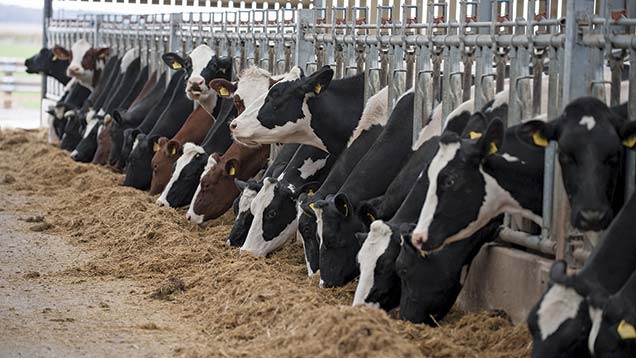Initial maize silage analysis looks positive
 (c) Angus Findlay
(c) Angus Findlay Initial analysis of maize silage indicates this year’s crop could be a welcome addition to dairy rations this winter.
Results from 1,300 forages show dry matter averaged 31.2% at 11.3ME, while starch degradability is up on the year to level at 69.2%.
Trouw Nutrition GB ruminant manager Adam Clay says he believes maize could help offset some of the problems created by this year’s grass silage.
Initial analysis of maize silage indicates this year’s crop could be a welcome addition to dairy rations this winter.
Results from 1,300 forages show dry matter averaged 31.2% at 11.3MJ of ME/kg of DM, while starch degradability is up on the year at 69.2%.
Trouw Nutrition GB ruminant manager Adam Clay says he believes maize could help offset some of the problems created by this year’s grass silage.
High energy content and dry matter, coupled with reduced neutral detergent fibre (NDF) levels, suggest maize silages will support increased performance, he adds.
In fact, anecdotal evidence shows many farmers have seen a positive yield response since introducing maize into the cows’ diet.
Starch levels are lower than last year, but are still good at 30.6% compared with 31.6% (2013-14). However, the starch is more degradable, which is significant.
“Higher starch degradability means more of the starch is used in the rumen. This increases the available rumen energy, which supports microbial growth.
“A more active rumen with higher microbial growth is important, as this drives dry matter intakes and yields. Promoting high intakes has been an issue with many grass silages this year, so this will be an added benefit from getting maize into diets,” says Mr Clay.
Although ME levels are marginally lower this year, rations will still need careful balancing to ensure cows’ total energy requirements are met, warns Mr Clay.
Acidosis risk
Despite the encouraging analysis and the prospects of a positive response once maize is introduced, dairy farmers do need to be aware of the increased risk of acidosis, says Mr Clay.
The most significant difference this year is an 8% reduction in by-pass starch. Including it in the diet is an effective method of increasing the total starch fed – and therefore glucogenic energy – in a rumen-friendly manner. Farmers will need to ensure they feed sufficient by-pass starch in the total diet to avoid subclinical acidosis.
“It will be essential to keep a close eye on rumen health to limit the risk and cost of subacute rumen acidosis. Reduced NDF and increased starch degradability could mean maize silage causes acidosis problems unless diets are carefully balanced and cows closely monitored.
“Furthermore, it is important to remember that starch degradability increases with time in the clamp, so the risk of disrupted rumen health could increase during the winter. For this reason we would recommend that maize is sampled monthly throughout the winter and diets fine-tuned for rumen-available starch levels, and to use a formulation package capable of identifying the speed in which carbohydrates are degraded in the rumen.”
Mr Clay also points out that a slight rise in pH means there may be problems with clamp stability. “Having made a good feed, make sure you minimise clamp losses. Avoid uncovering the clamp too quickly and make sure the face isn’t disturbed too much to prevent the ingress of air.”
|
Maize silage analyses |
||
|
|
2013-14 average |
Early 2014 average |
|
Dry matter (%) |
32.3 |
31.2 |
|
Crude protein (%) |
7.9 |
8.0 |
|
D-value (%) |
72.5 |
71.5 |
|
ME (MJ/kgDM) |
11.4 |
11.3 |
|
Starch (%) |
31.6 |
30.6 |
|
Starch degradability (%) |
67.7 |
69.2 |
|
By-pass starch (g/kg DM) |
102.2 |
94.1 |
|
NDF (%) |
42.0 |
41.7 |
|
pH |
3.9 |
4.0 |
|
Source: Trouw Nutrition GB |
||
